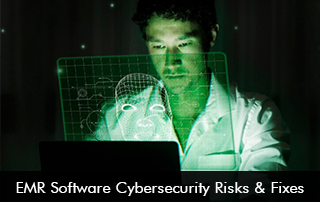EMR software has revolutionized healthcare by streamlining patient data management, improving care coordination, and enhancing clinical workflows. However, as healthcare organizations increasingly rely on digital systems, EMR software has become a prime target for cyberattacks. Protecting sensitive patient data is critical to maintaining trust and compliance with regulations like HIPAA.
In this blog, we’ll explore the major EMR software cybersecurity risks and provide actionable fixes to safeguard your systems.
1. Understanding EMR Software Cybersecurity Risks
EMR software stores vast amounts of sensitive patient information, making it a lucrative target for cybercriminals. Below are the most pressing cybersecurity risks associated with EMR systems.
Phishing and Social Engineering Attacks
Cybercriminals often use phishing emails or fake login pages to trick healthcare staff into revealing credentials. Once inside, attackers can access and exfiltrate patient data.
Ransomware Attacks
Ransomware encrypts EMR software data, locking healthcare providers out until a ransom is paid. These attacks disrupt patient care and lead to significant financial losses.
Insider Threats
Employees with malicious intent or poor security practices can accidentally or intentionally leak sensitive data. Unauthorized access by staff members is a major concern.
Weak Authentication and EMR Software Access Controls
Many EMR systems still rely on weak passwords or lack multi-factor authentication (MFA), making unauthorized access easier for hackers.
Outdated EMR Software and Unpatched Vulnerabilities
Failure to update EMR software leaves known security flaws unaddressed, allowing cybercriminals to exploit them.
Third-Party EMR Software Vendor Risks
Many healthcare providers use third-party integrations (e.g., billing, lab systems) that may have weaker security, creating backdoors into EMR systems.
Data Breaches Due to Improper Encryption
If EMR data is not encrypted both at rest and in transit, hackers can intercept and steal sensitive patient information.
2. Essential Fixes to Secure EMR Software
To mitigate these risks, healthcare organizations must implement robust cybersecurity measures. Below are key strategies to enhance software security.
Implement Strong Access Controls
-
Enforce multi-factor authentication (MFA) for all users.
-
Apply role-based access control (RBAC) to limit data access based on job functions.
-
Regularly review and revoke unnecessary user permissions.
Train Staff on Cybersecurity Best Practices
-
Conduct regular security awareness training to prevent phishing and social engineering attacks.
-
Teach employees how to recognize suspicious emails and report potential threats.
Keep EMR Software Updated
-
Apply security patches and updates as soon as they are released.
-
Schedule regular system audits to identify vulnerabilities.
Encrypt EMR Data
-
Use end-to-end encryption for data both in transit and at rest.
-
Ensure encryption protocols meet industry standards (e.g., AES-256).
Deploy Advanced Threat Detection
-
Use AI-driven intrusion detection systems (IDS) to monitor suspicious activities.
-
Implement behavioral analytics to detect anomalies in user access patterns.
Backup EMR Data Regularly
-
Maintain automated, encrypted backups stored in a secure off-site location.
-
Test backup restoration processes to ensure quick recovery from ransomware attacks.
Secure Third-Party Integrations
-
Vet vendors for compliance with HIPAA and other security standards.
-
Use API security measures to protect data shared with third-party applications.
Develop an Incident Response Plan
-
Establish a clear cybersecurity incident response plan to minimize damage in case of a breach.
-
Conduct regular drills to ensure staff know how to respond to cyber threats.
3. Compliance and EMR Software Security
Healthcare organizations must comply with HIPAA, GDPR, and HITRUST regulations to protect patient data. Below are key compliance considerations.
HIPAA Compliance for EMR Software
-
Ensure EMR software meets HIPAA Security Rule requirements for data protection.
-
Conduct regular risk assessments to identify and address security gaps.
GDPR and International Data Protection
-
Ensure GDPR compliance with strict data privacy controls for organizations handling EU patient data.
-
Implement data anonymization where possible to reduce exposure risks.
Regular Audits and Penetration Testing
-
Perform yearly security audits to assess EMR software vulnerabilities.
-
Conduct penetration testing to simulate cyberattacks and identify weaknesses.
4. Future Trends in EMR Software Security
As cyber threats evolve, EMR software must adapt with advanced security measures.
AI and Machine Learning for Threat Detection
-
AI can analyze vast amounts of data to detect unusual access patterns in real time.
Blockchain for Secure Health Data Exchange
-
Blockchain technology can provide tamper-proof audit logs for EMR access and modifications.
Zero Trust Security Models
-
Adopting a Zero Trust framework ensures continuous verification of users and devices before granting access.
Conclusion
EMR software is a critical component of modern healthcare, but its security risks cannot be ignored. By implementing strong access controls, encryption, staff training, and compliance measures, healthcare organizations can protect sensitive patient data from cyber threats.
Proactive security strategies, continuous monitoring, and staying updated with the latest cybersecurity trends will ensure that EMR remains a safe and reliable tool for delivering quality patient care.
Is your organization taking the necessary steps to secure its EMR systems? Let us know in the comments!








